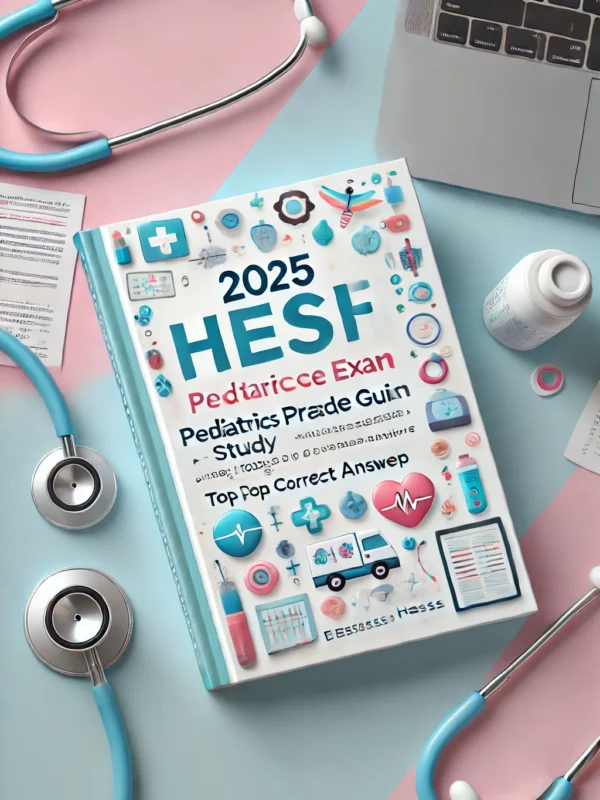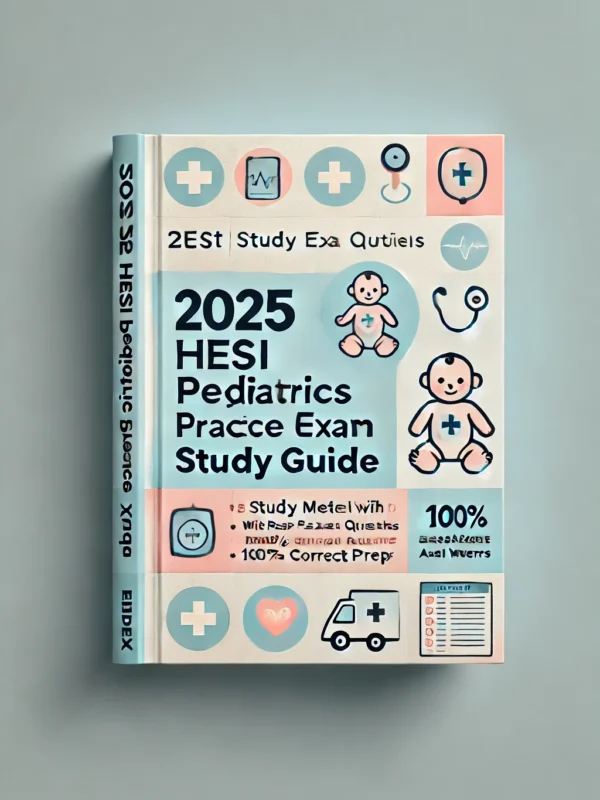The 2025 Exam 1 for Psychiatric and Mental Health Nursing – Full Review with 60 Quiz Questions, Answers, and Study Tips is an all-encompassing study resource tailored for nursing students and professionals preparing for Exam 1 in psychiatric and mental health nursing in 2025. This guide features 60 expertly curated quiz questions that mirror the exam’s format and difficulty, covering core topics such as mental health disorders (e.g., bipolar disorder, PTSD, and personality disorders), therapeutic communication techniques, psychotropic medications, and patient safety in psychiatric settings. Each question is accompanied by concise answers and practical study tips, offering insights into key concepts like the stages of grief, adverse effects of antipsychotics, and the use of the SAD PERSONS scale for suicide risk assessment. The guide also addresses high-yield areas such as milieu therapy, seclusion and restraint protocols, and cultural considerations in mental health care, ensuring a well-rounded preparation. Aligned with the latest psychiatric nursing standards, this resource is perfect for nursing school exams, NCLEX preparation, or certifications like the Psychiatric-Mental Health Nursing Certification (PMH-BC). It includes actionable study strategies, such as mnemonics for remembering psych meds and tips for managing test anxiety, making it an essential tool for mastering psychiatric nursing content and delivering high-quality, empathetic care.
Preview
A suspicious, socially isolated patient lives alone, eats one meal a day at a local shelter,
and spends the remaining daily food allowance on cigarettes. Select a community
psychiatric nurse’s best initial action.
a. Explore ways to help the patient stop smoking.
b. Report the situation to the manager of the shelter.
c. Assess the patient’s weight; determine foods and amounts eaten.
d. Arrange hospitalization for the patient in order to formulate a new treatment plan. – –
correct ans- -ANS: C
Assessment of biopsychosocial needs and general ability to live in the community is called
for before any other action is taken. Both nutritional status and income adequacy are
critical assessment parameters. A patient may be able to maintain adequate nutrition
while eating only one meal a day. The rule is to assess before taking action. Hospitalization
may not be necessary. Smoking cessation strategies can be pursued later.
A nurse surveys medical records. Which finding signals a violation of patients’ rights?
a. A patient was not allowed to have visitors.
b. A patient’s belongings were searched at admission.
c. A patient with suicidal ideation was placed on continuous observation.
d. Physical restraint was used after a patient was assaultive toward a staff member. – –
correct ans- -ANS: A
The patient has the right to have visitors. Inspecting patients’ belongings is a safety
measure. Patients have the right to a safe environment, including the right to be protected
against impulses to harm self.
Which principle has the highest priority when addressing a behavioral crisis in an inpatient
setting?
a. Resolve the crisis with the least restrictive intervention possible.
b. Swift intervention is justified to maintain the integrity of a therapeutic milieu.
c. Rights of an individual patient are superseded by the rights of the majority of patients.
d. Patients should have opportunities to regain control without intervention if the safety of
others is not compromised. – – correct ans- -ANS: A
The rule of using the least restrictive treatment or intervention possible to achieve the
desired outcome is the patient’s legal right. Planned interventions are nearly always
preferable. Intervention may be necessary when the patient threatens harm to self.
and spends the remaining daily food allowance on cigarettes. Select a community
psychiatric nurse’s best initial action.
a. Explore ways to help the patient stop smoking.
b. Report the situation to the manager of the shelter.
c. Assess the patient’s weight; determine foods and amounts eaten.
d. Arrange hospitalization for the patient in order to formulate a new treatment plan. – –
correct ans- -ANS: C
Assessment of biopsychosocial needs and general ability to live in the community is called
for before any other action is taken. Both nutritional status and income adequacy are
critical assessment parameters. A patient may be able to maintain adequate nutrition
while eating only one meal a day. The rule is to assess before taking action. Hospitalization
may not be necessary. Smoking cessation strategies can be pursued later.
A nurse surveys medical records. Which finding signals a violation of patients’ rights?
a. A patient was not allowed to have visitors.
b. A patient’s belongings were searched at admission.
c. A patient with suicidal ideation was placed on continuous observation.
d. Physical restraint was used after a patient was assaultive toward a staff member. – –
correct ans- -ANS: A
The patient has the right to have visitors. Inspecting patients’ belongings is a safety
measure. Patients have the right to a safe environment, including the right to be protected
against impulses to harm self.
Which principle has the highest priority when addressing a behavioral crisis in an inpatient
setting?
a. Resolve the crisis with the least restrictive intervention possible.
b. Swift intervention is justified to maintain the integrity of a therapeutic milieu.
c. Rights of an individual patient are superseded by the rights of the majority of patients.
d. Patients should have opportunities to regain control without intervention if the safety of
others is not compromised. – – correct ans- -ANS: A
The rule of using the least restrictive treatment or intervention possible to achieve the
desired outcome is the patient’s legal right. Planned interventions are nearly always
preferable. Intervention may be necessary when the patient threatens harm to self.












Reviews
There are no reviews yet.